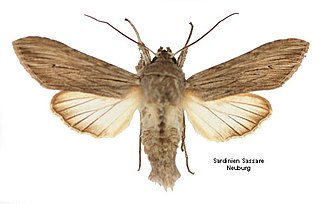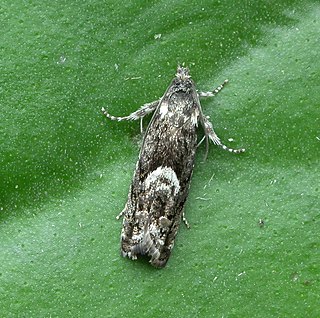
The Tortricidae are a family of moths, commonly known as tortrix moths or leafroller moths, in the order Lepidoptera. This large family has over 11,000 species described, and is the sole member of the superfamily Tortricoidea, although the genus Heliocosma is sometimes placed within this superfamily. Many of these are economically important pests. Olethreutidae is a junior synonym. The typical resting posture is with the wings folded back, producing a rather rounded profile.

Urodidae or "false burnet moths" is a family of moths in the lepidopteran order. It is the type genus in the superfamily, Urodoidea, with three genera, one of which, Wockia, occurs in Europe.

Bibasis harisa, the orange awlet, is a species of hesperid found in Asia. The butterfly was reassigned to genus Burara by Vane-Wright and de Jong (2003) and is considered by them to be Burara harisa.

Bibasis vasutana, the green awlet, is a species of hesperid butterfly found in Asia. The butterfly was reassigned to genus Burara by Vane-Wright and de Jong (2003) and is considered by them to be Burara vasutana.

Pandemis heparana, the dark fruit-tree tortrix or apple brown tortrix, is a moth of the family Tortricidae.

Ptyoptila is a monotypic moth genus of the family Oecophoridae described by Alfred Jefferis Turner in 1946. Its only species, Ptyoptila matutinella, was described by Francis Walker in 1864. It is found in Australia, where it has been recorded from Queensland, New South Wales, the Australian Capital Territory and Victoria.

Idaea flaveolaria is a moth of the family Geometridae first described by Jacob Hübner in 1809.

Emmelina aethes is a moth of the family Pterophoridae. It is found in Mexico.

Hellinsia cristobalis is a moth of the family Pterophoridae. It is found on the Galapagos Islands.

Hellinsia devriesi is a moth of the family Pterophoridae. It is found on the Galapagos Islands and Guadeloupe.

Hyblaea constellata is a moth in the family Hyblaeidae first described by Achille Guenée in 1852. It is found in India, Sri Lanka, south-east Asia, including China, Japan, Taiwan, Myanmar and Thailand. It is also found in Queensland, Australia.
Coamorpha is a genus of moths in the family Megalopygidae. It contains only one species, Coamorpha innoxia, which is found in Costa Rica.

Cucullia tanaceti is a moth of the family Noctuidae. The species was first described by Michael Denis and Ignaz Schiffermüller in 1775.

Endothenia ericetana is a species of moth, belonging to the family Tortricidae first described by Henry Noel Humphreys and John O. Westwood in 1845.

Rhopobota stagnana is a moth belonging to the family Tortricidae. The species was first described by Michael Denis and Ignaz Schiffermüller in 1775.

Lobesia fuligana is a moth belonging to the family Tortricidae. The species was first described by Adrian Hardy Haworth in 1811. It is found in Europe.

Lobesia reliquana is a moth belonging to the family Tortricidae. The species was first described by Jacob Hübner in 1825.

Ancylis uncella is a moth belonging to the family Tortricidae. The species was first described by Michael Denis and Ignaz Schiffermüller in 1775.

Pammene giganteana is a micromoth belonging to the family Tortricidae. The species was first described by Henri de Peyerimhoff in 1863.

Pammene albuginana is a moth belonging to the family Tortricidae. The species was first described by Achille Guenée in 1845.






















